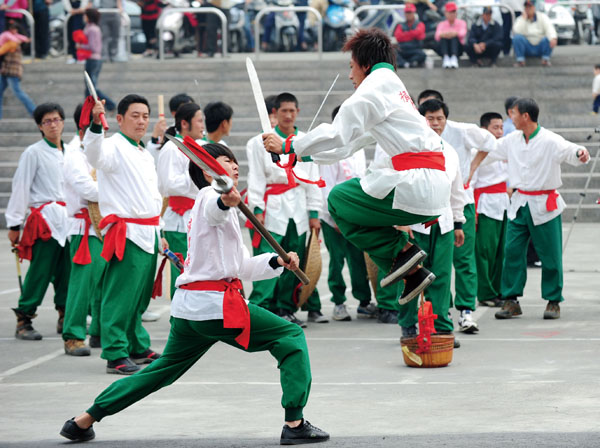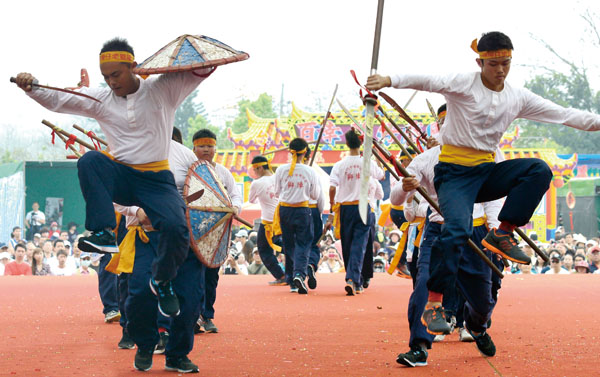Neimen Song Jiang Battle Array/情義參天 內門宋江陣的文化藝術饗宴
Neimen Song Jiang Battle Array
◎English translation: Peng Hsin-yi ◎Photos by Chang-Chian Ying-hao, Pao Chung-hui
| |
 |
|
| |
依2013內門宋江陣官網統計,目前內門宋江陣陣頭約有26隊,密度冠全臺,故內門又有「宋江窟」之稱。
Neimen has around 26 battle-array troupes, more than anywhere else in Taiwan and making the district the capital of Taiwan's battle-array Culture. |
|
The Song Jiang Battle Array in Neimen is a very special cultural event, which is celebrated on Guanyin and Buddha's birthdays in March. It has been ranked as one of Taiwan's top twelve festivals, attended by many tourists and anticipated by locals. It also features a festive parade of characters that come from folklore, myths, historical events and religious stories. This allows for these stories to be passed down through the generations.
There are several theories regarding the origins of the Song Jiang Battle Array. Most historians believe it originated in China in the Ming Dynasty. Mr. Chen Ceng-sian from the Ruohan Cultural Historical Studies Center, explained when the Ming Dynasty fell, General Jheng Cheng-gong retreated to Taiwan with what remained of the Ming military. They set up camps in Youying (present day Neimen), The Ming military disbanded, became civilians and developed enclaves. Neimen is surrounded by mountainous terrain and isolated from other enclaves. The residents were often raided by bandits and savages and therefore organized a militia group to protect the village. It is theorized an annual parade was established to give thanks for Guanyin and Buddha's protection on their Birthdays.
 The Song Jiang Battle Array gradually evolved from a military parade into a festival. People began participating in the array, dressed up like classical Chinese literature heroes such as Shui Hu Zhuan. This added a theatrical element to the parade and eventually became more about local entertainment. However, to remain true to its roots, the array is always led by a soldier carrying a flag. Participants in the parade carry a variety of weapon such as axes, spear- daggers (a pole with a blade that is longer than a dagger attached at the top), staffs, scimitars, swards, dagger-scimitar (a single blade similar to the scimitar but shorter) and chicken-whips. The chicken-whips are unique to the Song Jiang Battle Array and made by splitting a bamboo into fine strips. The whips, which were originally used to herd chickens and symbolic of the early days when life was more difficult, therefore giving them prominent significance in the array. There are many routines that are carried out during the array, with the most complicated being the two hour "Bagua Array" (Eight Trigrams). Several Arrays have also developed; one of which being the "Flag Array" where the leader carries a flag. Another variation is the lion, dragon or crane dances known as "Lion Array", "Dragon Array" or "Crane Array".
The Song Jiang Battle Array gradually evolved from a military parade into a festival. People began participating in the array, dressed up like classical Chinese literature heroes such as Shui Hu Zhuan. This added a theatrical element to the parade and eventually became more about local entertainment. However, to remain true to its roots, the array is always led by a soldier carrying a flag. Participants in the parade carry a variety of weapon such as axes, spear- daggers (a pole with a blade that is longer than a dagger attached at the top), staffs, scimitars, swards, dagger-scimitar (a single blade similar to the scimitar but shorter) and chicken-whips. The chicken-whips are unique to the Song Jiang Battle Array and made by splitting a bamboo into fine strips. The whips, which were originally used to herd chickens and symbolic of the early days when life was more difficult, therefore giving them prominent significance in the array. There are many routines that are carried out during the array, with the most complicated being the two hour "Bagua Array" (Eight Trigrams). Several Arrays have also developed; one of which being the "Flag Array" where the leader carries a flag. Another variation is the lion, dragon or crane dances known as "Lion Array", "Dragon Array" or "Crane Array".
The Neimen Song Jiang Battle Array brings to life the ongoing struggles of the ancestors." It is truly a humbling experience" says Mr. Chen. "By fully appreciating the lives of our forefathers of three-hundred years ago, we become the bearers of their hope and dreams. We become responsible for passing them down to generations who will be around in three-hundred years from now". Mr. Chen is not alone in these sentiments, currently Neimen has twenty-six arrays that are sponsored by local temples and organized by local residents. Neimen is the official home of Taiwan's battle arrays.
The 2013 Song Jiang Array Festival will take place on March 30th, at the Shunsian Temple. The program will include a parade with several local arrays, creative arrays from local colleges and followed by Holy Sedans carrying statues of Guanyin and Buddha. Banquets prepared by many local banquet chefs always follow. Director Lin Yi-an of Neimen Elementary School shares some protocol for visitors to follow if they attend the festival. First and foremost, do not walk into an array while it is in progress. Do not cross the road while the array is passing by or stand in the middle of the road while the Array is approaching, as it is regarded as blocking the array and causing a disturbance.
情義參天 內門宋江陣的文化藝術饗宴
◎文/盧怡如 ◎攝影/張簡英豪、鮑忠暉
 每年3月配合觀音佛祖誕辰舉辦的「內門宋江陣嘉年華」,為臺灣十二項重大節慶之一,活動融合人物、故事、文化、民俗、宗教、歷史與創意等元素,不僅為內門宋江陣增添多元面貌,同時也賦予高雄在地民俗文化嶄新的價值。
每年3月配合觀音佛祖誕辰舉辦的「內門宋江陣嘉年華」,為臺灣十二項重大節慶之一,活動融合人物、故事、文化、民俗、宗教、歷史與創意等元素,不僅為內門宋江陣增添多元面貌,同時也賦予高雄在地民俗文化嶄新的價值。
「內門宋江陣」起源眾說紛云,學界認為應與明代軍事訓練有關,「明末清初鄭成功率軍來台,並於『右營』(即現在的內門)屯兵駐紮,清康熙年間施琅擊敗明鄭軍隊後,部分官兵遂落地生根,在內門居住下來。」羅漢門文史尋根工作室陳聰賢老師娓娓道來。「因內門四周崇山峻嶺,先民常遭土匪搶劫,各村落為抵禦外侮,紛紛自行設館自衛 ;同時配合觀音佛祖遶境,為感謝神明護佑,遂在神佛駕前表演最擅長的『宋江陣』以表虔誠。」
演變至今,內門宋江陣融合「水滸傳」的劇情故事,成為結合傳統武術和民俗技藝的廟會陣頭。宋江陣成員人手一樣兵器,有頭旗、雙斧、官刀、齊眉棍 、雙刀、雙劍、躂刀、雞掃等。其中雞掃為內門宋江陣獨有之兵器。陣式則隨各區域的演練而不同,其中最具威力的是「八卦陣」,完整的一套打完則需二個多小時。除了「跋頭旗」(頭旗從頭到尾猛力的搖個不停)的宋江陣外,還有「跋獅頭」的宋江獅陣、「跋龍頭」的宋江龍陣和「跋白鶴」的宋江鶴陣。
 「瞭解內門宋江陣的背景淵源,可感受先人開墾的篳路藍縷與樸實、虔誠,讓自己的生命力往前推展300年。」陳聰賢老師感性地說。除了歷史背景因素 ,因社區民眾的凝聚力和廟宇的大力支持,內門宋江陣現有26個陣頭,內門也因此獲得「臺灣陣頭之鄉」的美譽。
「瞭解內門宋江陣的背景淵源,可感受先人開墾的篳路藍縷與樸實、虔誠,讓自己的生命力往前推展300年。」陳聰賢老師感性地說。除了歷史背景因素 ,因社區民眾的凝聚力和廟宇的大力支持,內門宋江陣現有26個陣頭,內門也因此獲得「臺灣陣頭之鄉」的美譽。
今年宋江陣嘉年華將於3月30日內門順賢宮舉行,活動內容包括文武大會陣頭串演、大專院校創意陣頭大賽、觀音佛祖聖駕遶境、內門總舖師饗宴等。內門國小林義安主任提醒,觀看宋江陣有兩大禁忌:一是禁止民眾入陣或從中穿越,因表示破陣之意;二是不可擋住正門或中道。